ID Tricky Birds


House Finch vs Purple Finch
House Finches and Purple Finches are commonly misidentified. Here in Indiana, we have House Finches all year, but the Purple Finches only visit during the winter. An easy way to tell them apart is the House Finches have a red head and chest, where as Purple Finches have a reddish-pink wash all over them: head, neck, chest, tail, wings. The almost look like they fell into a glass of grape juice and stained their feathers.
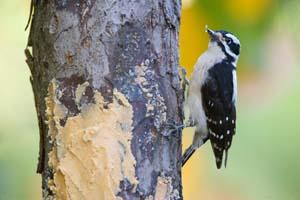
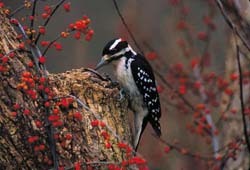
Downy Woodpecker vs Hairy Woodpecker
Downy Woodpeckers are some of the most common suet-eating birds, but their cousin the Hairy Woodpecker is often mistaken for them. There are two main ways to tell them apart based on your view of them: their tail and their beak. Downy Woodpeckers tails are very speckled and covered in white dots and stripes like their wings. Hairy Woodpecker tails are black on top and white on bottom; no speckles. Downy Woodpeckers also have much shorter beaks; they are roughly the same distance from beak to tip as from beak to eyeball. Hairy Woodpecker have bills that are just about twice as long; roughly the same distance from beak to tip and from beak to the back of their head.
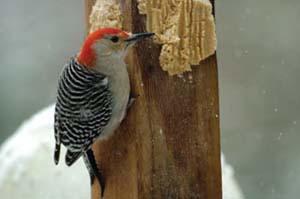
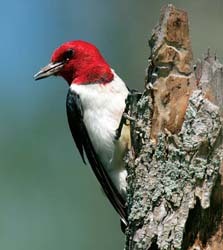
Red-bellied Woodpecker vs Red-headed Woodpecker
This is another pair that is not often truly mistaken for one another, but more commonly just misnamed. Many woodpeckers have red heads in one way or another, but the Red-headed Woodpecker is the only one with an all red head, including its face. The Red-bellied Woodpecker only has a red cap and nape, and a slight red wash on its stomach.
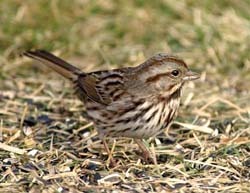
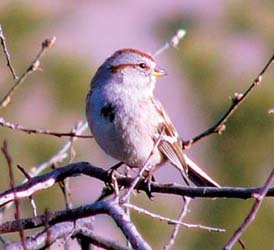
Song Sparrow vs American Tree Sparrow
While the Song Sparrow stays all years and is familiar to many backyard birdfeeders, its cousin the American Tree Sparrow can make identifying hard when he comes to visit during the winter. The Song Sparrow and the American Tree Sparrow can look very similar at first, but the trick is to look at the chest and the brow. The American Tree Sparrow has a clear chest with one central dark spot and a solid, rusty-colored cap. The Song Sparrow has a streaky chest with a large central spot and a stripe down the middle of his head that interrupts the rusty cap.
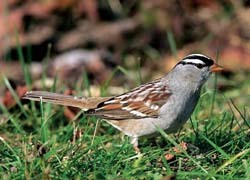

White-crowned Sparrow vs White-throated Sparrow
Both of these winter visitors can be easily misidentified as one another, especially since they both have a white crown! The easiest way to tell them apart is the brow, throat, and bill. While the White-crowned Sparrow does share his black-and-white striped cap with his cousin, he has a clear brow, gray chest and throat, and a yellow-orange bill. The White-throated Sparrow, on the other hand, has a vibrant yellow spot on his brow, a white bib on his throat, and a black or brown bill.
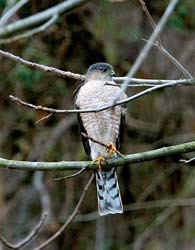
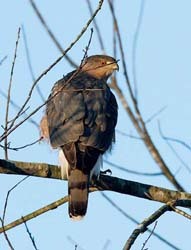
Sharp-shinned Hawk vs Coopers Hawk
Both of these birds of prey are year round visitors, but identifying them without putting them in a lineup can be difficult. The Coopers Hawk is larger than the Sharp-shinned, but only by a few inches, so that can get confusing. The three best places to look is the back of their head, their tail, and their silhouette. The Sharp-shinned Hawk could also be called the hooded hawk. Its gray cap extends all the way down the back of its neck to join with is gray body. The Coopers Hawk, however, has white at the nape of his neck, interrupting the gray. The Sharp-shinned has a longer, square tail when compared to the Coopers Hawk's shorter rounded one. The Sharp-shinned also has broad shoulders and a slimmer silhouette compared the the Coopers's thicker, fluffier body.
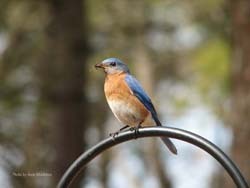

Eastern Bluebird vs Blue Jay
While not commonly mistaken for one another, these birds are commonly mislabeled because of the word "blue" in their names. One hears "I had a blue bird in my yard" and wonders if the speaker meant they had an Eastern Bluebird or a bird that was blue like a Blue Jay, Indigo Bunting, Barn Swallow, and Tree Swallows.

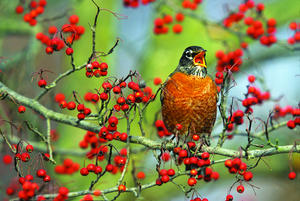
Eastern Bluebird vs American Robin
There is actually no such thing as a blue feather; it's all a trick of the light. White light bounces off of specially-made feathers so that it reflects back blue, creating the vibrant blue you see on Eastern Bluebirds. However, since the feather is not actually dyed blue, in dull light like on a cloudy day, Eastern Bluebirds can appear almost gray or black, making them look like very small American Robins. The easiest way to tell them apart is by looking for the white underbelly and paying attention to where they are in your yard. Eastern Bluebirds have a white area underneath their rusty red chest and like to eat mealworms, Bark Butter Bits, and sunflower chips from feeders. American Robins, however, have little to no white, and prefer to eat bugs and fruits off the ground.

